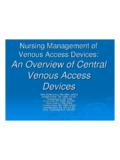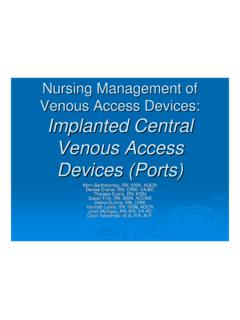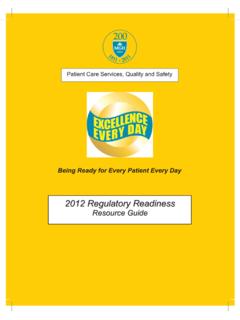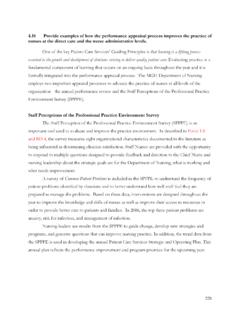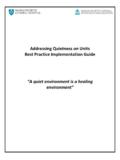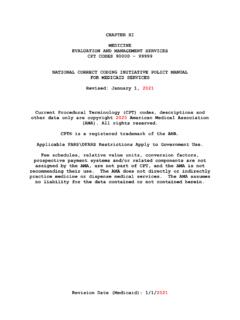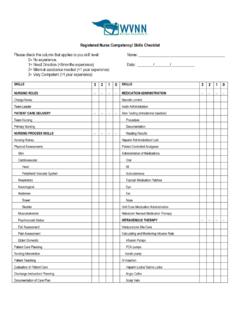Transcription of Nursing Management of Venous Access Devices: …
1 Nursing Management of Venous Access Devices: peripherally Inserted central catheter (PICC)Mimi Bartholomay, RN, MSN, AOCND enise Dreher, RN, CRNI, VA-BCSally Geary, RN, MS, CCNSR eviewed/Revised Feb., 2019 peripherally Inserted central catheter (PICC)oBenefits Long-term Access - dwell time varies (can be > one year) Decreased length of stay in hospital allows for IV therapy in non-acute settings, , home care /hospice/ skilled Nursing facility (SNF) Cost effective compared to all other central VADs Decreased infection rate, as compared with other non-tunneled CVADs Patient satisfaction and comfort Fewer interruptions in IV therapyPICCsoRisks: Air embolism Infection Deep vein thrombosis (DVT) Nerve damage Increased heparin usage in some PICCsoOther considerations: Blood withdrawal can be difficult; may be dependent on catheter length.
2 Over time, multiple insertions can cause Venous scarring and decrease the ability to reuse the sitePICC CharacteristicsoCatheter types: single lumen (SL) double lumen (DL) triple lumen (TL) oCatheter sizes: 2F to 6 FoCatheter styles: non-power PICC Power PICC saline-only or valvedPICC (Solo )oCatheter lengths: cut to specific patient-dependent lengthPICC PlacementoPlacement Successful placement is highly technique-dependent; requires formal training. A sterile procedure performed at bedside by specially trained IV nurse or by Interventional Radiology. catheter tip location verified by chest xray(cxr) or using EKG tip positioning system (TPS) technology (see next slide).
3 OContraindicated in extremities affected by Axillary lymph node dissection Tissue damage such as burns, cellulitis, fracture, rotator cuff tear Vessel occlusion / DVT(deep Venous thrombosis)/SVT(superficial Venous thrombosis) Dialysis catheter (AVF) in same arm Vein preservation for future dialysis Access needs Newly implanted pacemaker or defibrillator Affected arm s/p stroke Arm edema/lymphedemaPICC Tip VerificationoVia Chest Xray(cxr): CXR is done when P waves on EKG are not present, identifiable, or consistent. Patient is < 18 years of age Verbiage in Line Properties section of procedure note: Placement Verification: post intervention verification pending Verbiage at end of procedure note: PICC tip location needs to be confirmed by chest xraydue to (reason).
4 Once cxris read, line will require an ok to use order PICC Tip VerificationoVia EKG Tip Positioning System (TPS) (aka 3CG): EKG TPS used when P waves are present, identifiable, and consistent CXR not needed for tip verification Approved for patients 18 years of age and older Verbiage in Line Properties section of procedure note: Placement verification: ECG done by IV nurse Verbiage at end of procedure note: PICC tip location in the SVC confirmed by ECG technology. PICC is now ready for immediate use .Multi-lumen PICCsDouble Lumen PICCT riple Lumen PICCI mages retrieved from permission 10/6/09 Other PICCsBard Power PICCBard Solo PICC(valved, saline flush only PICC)Images retrieved from permission 10/6/09 Solo PICC has characteristic bubble PICC AssessmentoPatient comments/complaints ( , pain, palpitations, hears something in ear when catheter flushed)oNew cardiac irritability: CXR to verify catheter tip locationoExtremity edema Is extremity cold or mottled in appearance?
5 Do arms appear to be same size? If for dependent edemaoAssess whether patient is favoring that armoCheck bicep circumferencesoRule out DVToRule out catheter fractureoCatheter migration (change in external catheter length since insertion): CXR to verify new catheter tip location Hold central -concentration infusatesuntil confirmation of central placementoConsult with IV Team for any issues or symptomsPICC Line Care: FlushingRefer to MGH Nursing Policies and Procedures in EllucidType of CatheterRoutine FlushingFrequency of FlushPICCs and power-injectable PICCs ( Bard Power PICC)Adults: 10-20ml of saline after infusion20-30ml of saline after blood draw or blood transfusionAdolescents:Heparin 10 units/ml; flush with 5ml (50 units).
6 Pedi/Toddlers/Infants:-2F catheter :Heparin 10 units/ml; flush with 1ml (10 units). catheter or larger:Heparin 10 units/ml; flush with 2-3ml (20-30 units).Intermittent use: After completion of any infusion or blood :Every 24 hours when not in completion of any infusion or blood sampling, every 24 hours when not in completion of any infusion or blood sampling, every 6 hours not in completion of any infusion or blood sampling, every 12 hours when not in usePICC Line Care: FlushingRefer to MGH Nursing Policies and Procedures in EllucidType of CatheterRoutine FlushingFrequency of FlushPICCs and power-injectable PICCs ( Bard Power PICC)Neonates/NICU:Single lumen PICCs are not lumens of multilumenPICCs may be heplockedin certain situations such as fluid 10units/ml.
7 Flush with 1ml (10units)All neonate/NICU infusions, including central line flushes, should be administered using a pump to reduce the risk of catheter completion of any infusion or blood sampling, or every 6 hoursDiscontinuing a PICCoPhysician/provider order required to discontinue PICCoProcedure highlights: Patient should be recumbent in bed Apply slow, steady traction when sliding catheter out Have patient perform Valsalva maneuver Place petroleum-based ointment, a sterile gauze, and occlusive dressing over insertion site. Dressing should remain on for at least 24 hours, or longer until epithelialization occurs Inspect catheter ; check tip integrity and length Consider tip culture if infection is suspectedoIf difficulty removing catheter , apply warm compresses to arm, shoulder, and chest to decrease venospasm.
8 If catheter remains steadfast, DO NOT FORCE. Secure catheter and notify to MGH Nursing Policies and Procedures in MGH Ellucidfor full procedurePICCs: MiscellaneousoMaximum infusion rate: as patient condition warrants. Pump maximum infusion rate is 999 are mandatory for anyinfusion!oNO blood pressure cuff or tourniquet on or above PICC new Stat-lock securement device should be applied with dressing and needleless connector and label a dedicated lumen if patient to be on TPN. Please be sure to flush and maintain prior to TPN initiation. oFor multi-lumen power PICCs, always have a power-injectable lumen available for ordered contrast power point 2011: Bartholomay, Dreher, Theresa Evans, Susan Finn, Deb Guthrie, Hannah Lyons, Janet Mulligan, Carol TyksienskioMGH EllucidoInfusion Nurses Society (INS), Infusion Nursing Standards of Practice, 2016
